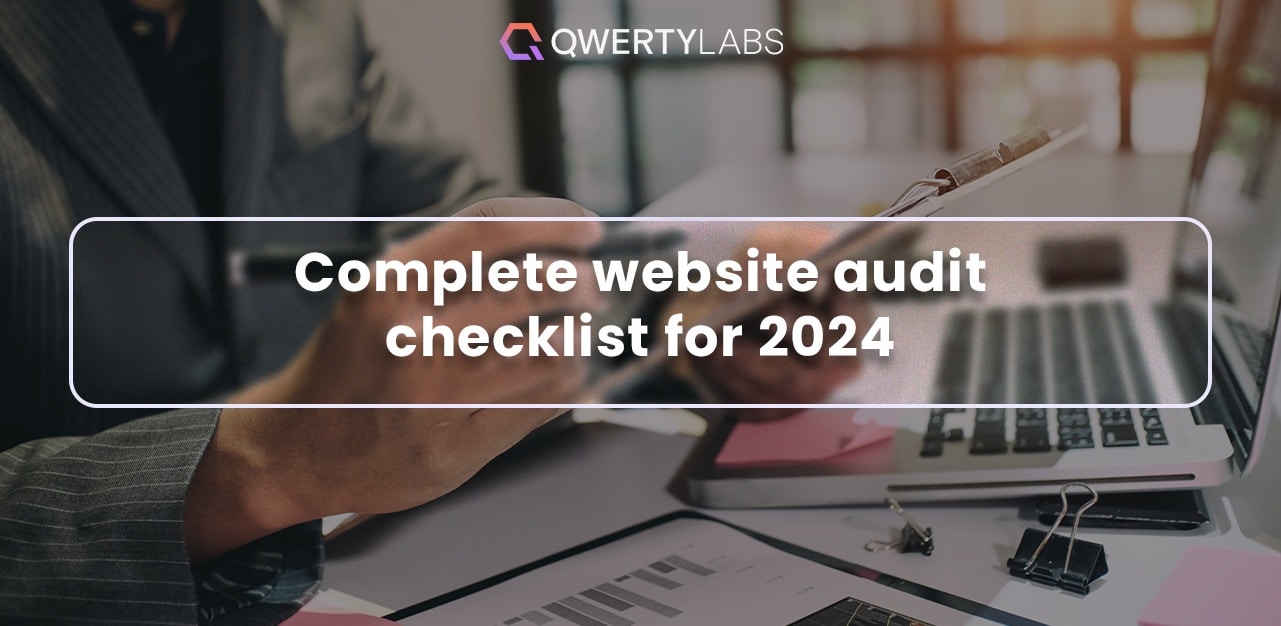Engage your audience with the right brand event marketing strategy. Discover tips and tricks to create impactful events with QWERTYLABS.

In today's ever-evolving digital landscape, having a strong online presence is crucial for the success of any site. To achieve this, knowing how to do website audit is important. This ensures that your site is optimised for high-quality performance.
A web page audit checklist serves as a valuable guide in the digital space. By following a website audit checklist 2024, you can identify issues or content gaps that may slow down your site's success. This ultimately leads to higher conversions, customer satisfaction, and overall success.
Here is a guide to QWERTYLABS’ website audit checklist:
A website audit is a process that evaluates the performance of a site for better search engine visibility. It involves an analysis of various factors:
The goal of a website audit template is to identify areas of improvement and correct issues that slow down a site's performance. By conducting a website audit, you can achieve business goals easier.
In the digital age, mobile responsiveness has become a huge part of the website SEO audit checklist. With the increasing use of phones and tablets, a huge portion of site traffic comes from mobile devices. With this, ensure that your site is mobile-friendly. This means that it has a smooth user experience across different screen sizes and browsers.
Also, mobile responsiveness is important because it directly impacts user experience. A mobile-friendly site adapts its layout and design to suit smaller screens. This makes it easier for users to navigate and interact with the site.
For instance, search engines like Google prioritise mobile-friendly websites in their rankings. Sites that are not optimised for mobile devices may see a decline in organic search traffic. This will result in missed chances for business growth.
Various tools can help check your site's mobile friendliness. These are:
Users expect sites to load fast and deliver a smooth browsing experience. Thus, including website speed and performance is important in a business' SEO audit checklist for 2024.
Loading speed has a huge impact on user experience. Studies show that users tend to abandon sites that take too long to load. This leads to high bounce rates and lost conversions.
A slow site can result in frustrated visitors. This affects customer satisfaction and brand perception. On the other hand, a fast-loading site enhances retention rates and increases the chances of conversions.
Site speed also influences search engine rankings. Search engines like Google consider loading speed to be a ranking factor. Websites that load fast are more likely to rank higher in search engine results pages (SERPs).
Including site speed and performance evaluation in a website audit allows you to identify any performance issues that may affect your page ranking. With this, you can take the right measures to optimise loading speed.
A website audit provides insights into various factors that affect site performance. These are:
By looking into these elements, you can find areas for improvement and implement strategies to enhance your site's speed and performance.
There are several ways on how to assess website speed and performance. To make it easier, here is a list of tools you should not miss out on:

User experience (UX) evaluation is vital to website auditing. It focuses on looking into how users interact with a site and aims to ensure that their time is seamless, intuitive, and enjoyable. Including UX evaluation in your site audit checklist for 2024 is crucial for several reasons.
A positive experience is important for retaining your target audience. In today's competitive digital landscape, users have high expectations regarding site usability. If a site fails to deliver a good experience, visitors are likely to leave and find other options. By evaluating UX, you can optimise navigation, streamline workflows, and enhance overall satisfaction.
UX also impacts key metrics such as conversion rates, bounce rates, and customer loyalty. A well-designed site that caters to users' needs can improve these metrics. This leads to increased engagement and revenue generation.
Search engines like Google also consider UX to be a ranking factor. Sites that offer a positive UX are more likely to rank higher in search engine results pages.
Conducting user experience evaluation can be overwhelming at first. Fortunately, there are several ways to audit your site effortlessly. Here is a quick checklist for UX audit:
By using this checklist, you can conduct a UX audit to enhance the overall user experience, improve engagement, and drive better results.
Another crucial part of the website audit checklist 2024 is content analysis. This involves assessing the quality, relevance, and accuracy of the content present on the site.
Relevant and high-quality content is needed to engage and retain visitors. Auditing the content helps you ensure that the information provided is up-to-date, valuable, and aligned with the needs of the target audience. By identifying outdated or irrelevant content, you can remove or update them to maintain a positive UX.
Accurate content builds trust and credibility. On the other hand, inaccurate information can harm your reputation and lead to customer dissatisfaction. Conducting a content analysis allows you to verify the accuracy of facts and statistics, ensuring that visitors receive reliable information.
A content analysis can help identify gaps in your content strategy. It assesses the effectiveness of your blog posts, articles, and other forms of content marketing.
Here are some tips to remember when analysing your site’s content quality:
Security assessment is a critical part of a website audit template in 2024. It involves assessing the security measures used on a site to protect it from cyber threats and ensure the safety of user data.
Keep in mind that security impacts user trust. In an era of increasing cyber threats, users want assurance that their info is protected when interacting with a site. A security assessment helps you identify weaknesses and take the right measures to protect user data.
A security breach can have severe outcomes. This includes data theft, financial loss, and reputation damage. By including security assessment in the website audit checklist, you can actively identify and address potential openings, lowering the risk of a breach.
The majority of the sites use Secure Sockets Layer or SSL. In fact, there is an updated version of the security protocol called Transport Layer Security (TLS). It basically creates a secure link between the browser and the server that ensures data security and privacy with any transaction made online.
Key aspects to assess include the presence of SSL certificates:

SEO is a crucial element that focuses on improving a website's visibility and ranking in SERPs, particularly Google. A well-optimised website is more likely to appear in top search results, increasing organic traffic and customer reach.
By having an SEO audit checklist, you can find areas for improvement in site structure, content, and technical aspects. Doing so will help enhance your site’s search engine rankings.
Keywords play a vital role in SEO. An audit helps you find relevant keywords and optimise your site's content accordingly. This ensures that their site appears in search results when users search for those particular keywords.
Also, optimising meta titles and meta descriptions is another crucial aspect of SEO. These elements provide concise info about a webpage and influence click-through rates.
Another crucial component of a website audit checklist is link profile analysis. This involves assessing the backlinks pointing to your site.
Authority and quality of backlinks are key factors that search engines consider when determining a site's ranking in search results. By conducting a link profile analysis, you can identify and remove any low-quality or spammy links that might negatively impact a site's ranking.
Another important aspect to consider is the relevance of the linking domains to the site's niche or industry. Search engines value links that come from sites with similar content. This indicates an organic link-building process. In contrast, links from irrelevant sites can be seen as deceptive and could result in penalties.
Anchor texts used in the backlinks are also important during link profile analysis. Organic anchor texts that reflect the content of the linked pages are preferred. However, excessive use of an exact match or keyword-rich anchor texts can raise red flags and trigger search engine penalties.
The overall link between diversity and growth patterns should also be assessed. A healthy link profile typically consists of a diverse range of domains and a steady, organic growth of backlinks over time. Sudden spikes or drops in the number of backlinks can indicate unnatural link-building practices.
To help you better analyse your site’s link profile, here are some tips to remember:
It is important to include conversion rate optimisation (CRO) in a site audit checklist for 2024. CRO focuses on improving the percentage of site visitors who take action on the site, such as buying, filling out a form, or subscribing to a newsletter.
CRO directly impacts revenue generation. By optimising the site to increase conversions, you can maximise the value they extract from their existing traffic, resulting in higher revenue.
Besides this, CRO, with a website SEO audit checklist, helps you better understand your customers and their preferences. By analysing user behaviour, conducting A/B tests, and implementing data-driven changes, you can tailor your site. Doing so will help you meet the needs and expectations of your target audience, leading to improved customer satisfaction and loyalty.
CRO aligns with the outcome-driven approach of digital marketing. Instead of focusing on driving traffic, CRO emphasises the importance of converting that traffic into valuable actions.
Conducting a website audit is crucial in 2024 as this helps companies improve their online presence, maximising their success. By following an audit checklist, you can identify areas for improvement and implement strategies to enhance your site's visibility, credibility, and conversions.
To further improve your online presence and optimise your site, consider the services of QWERTYLABS. With their expertise in SEO, content creation, and website analysis, you can enhance your website's performance, attract more organic traffic, and convert visitors into valuable customers.
Take advantage of tailored solutions and industry knowledge offered to stay ahead in the competitive digital landscape of 2024. Don't miss out on the chance to elevate your online presence. Contact QWERTYLABS today and unlock the full potential of your website!
How to do a website audit?
Conduct a website audit by assessing various aspects. This includes website performance, SEO, content quality, user experience, security, and analytics to identify areas for improvement.
Is website auditing necessary?
Yes, a website audit is necessary. This will help assess the overall health and effectiveness of your website, identify issues, and implement strategies for improvement.
What tools can I use for a website audit in 2024?
There are tons of tools available that you can use when auditing a website. Some popular ones are:
What is a website audit and how does it contribute to a website's success in 2024?
A website audit helps identify and address issues hindering a site's performance, user experience, SEO, and security. This allows you to optimise your site for better visibility, engagement, and conversions in 2024's competitive landscape.
What role does security assessment play in a website's audit checklist?
Security assessment ensures that a site is protected from cyber threats, builds user trust, and protects sensitive information. These help reduce the risk of data breaches and potential reputational damage.
How often should I conduct a website audit?
It is recommended that websites be audited at least once a year. However, this can vary depending on the website's size, industry, and any significant changes or updates.

 A guide to proper brand event marketing to elevate your business
A guide to proper brand event marketing to elevate your business
Engage your audience with the right brand event marketing strategy. Discover tips and tricks to create impactful events with QWERTYLABS.
 Cybersecurity trends 2024: What online casinos should know
Cybersecurity trends 2024: What online casinos should know
Stay on top of your site's cyber security by learning trends like Zero Trust Security and Supply Chain Attacks. Learn more about it at QWERTYLABS.
 The latest Google search algorithm updates for SEO success
The latest Google search algorithm updates for SEO success
In 2024, Google remains the top choice for finding answers online. That’s why it continuously refines its search policies and algorithms to improve user experience (UX) and provide more accurate search results.
8F, One Trium Tower,
Filinvest Avenue, Alabang, Muntinlupa, Metro Manila
Philippines, 1799
[email protected]
+63 (02) 8971 8926